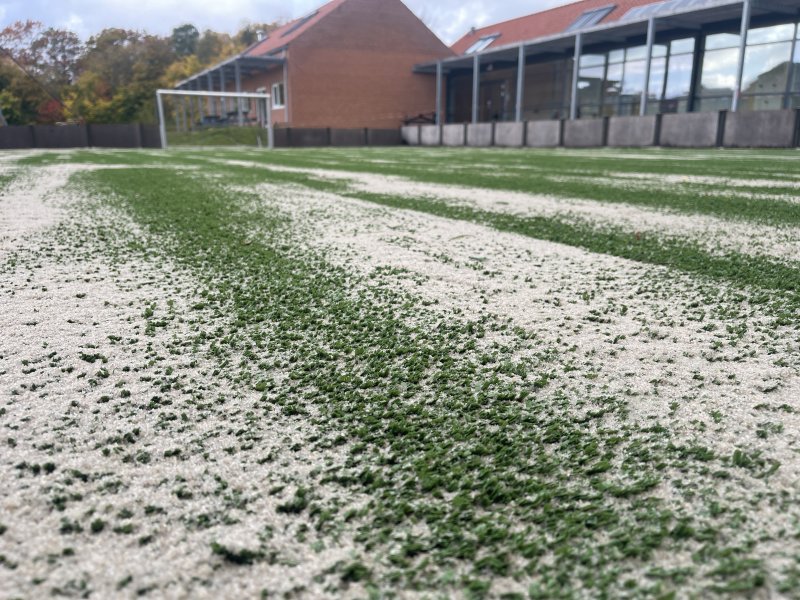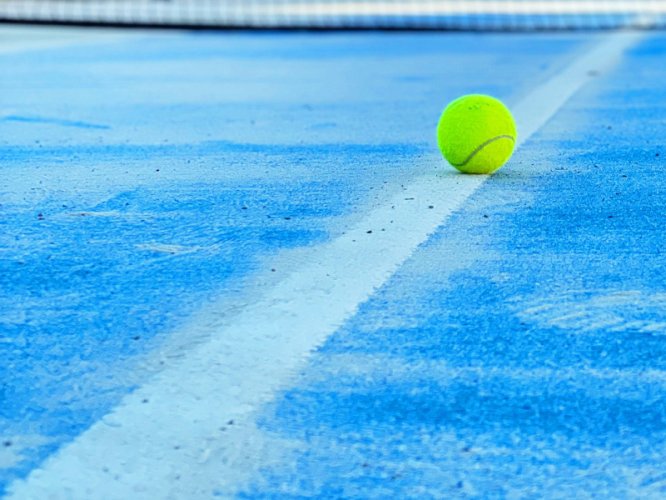Environmental considerations in practice: This is how artificial grass pitches can become more susta

There has been much discussion about the environmental impact of artificial grass pitches, particularly in relation to the chemicals used in the production of artificial grass and in artificial grass infill.
In this blog post, we will review the following topics:
• Control of chemicals used in the production of artificial grass
• PFAS free artificial grass
• The reusable artificial grass of the future
• Alternatives to rubber granules
• Recommendations from DTU
Test of artificial grass according to the Reach standard
REACH stands for Registration, Evaluation, Authorization and Restriction of Chemicals (registration, evaluation, approval and restriction of chemicals), and it is a European legislation that aims to protect human health and the environment from dangerous chemicals. REACH requires all chemicals imported or manufactured in the EU to be registered and tested to ensure they are safe to use.
Artificial grass is typically made from plastic materials, which can contain chemicals that can be harmful to people and the environment if they have not been properly tested. It is therefore important that artificial grass manufacturers ensure that their products comply with REACH standards.
By testing artificial grass according to the REACH standard, you can ensure that there are no dangerous chemicals in the products that could pose a risk to human health or the environment. This can help protect both consumers and the environment from hazardous chemicals and their potential health effects.
In addition, compliance with REACH standards can also help artificial grass manufacturers to ensure that their products meet the regulatory requirements of the EU.
The Reach standard was introduced in 2007 to protect human health and the environment against harmful chemicals. The standard is continuously updated so that it is always up-to-date, however, PFAS is not yet fully integrated, but there are plans to further regulate and limit the use of PFAS according to the REACH regulation.
Great focus on PFAS.
PFAS (per- and polyfluorinated alkyl substances) are used in some types of artificial grass to make them more resistant to water and stains. These chemicals are water repellent and can help prevent water from being absorbed into the artificial grass, which can reduce the risk of mold and bacterial growth. In some cases, they have also been used in the production of artificial grass to protect against UV radiation and extend the life of the product.
However, there are concerns about the use of PFAS in artificial grass, as some types of PFAS are toxic and can have negative health effects on people and the environment. PFAS also break down very slowly and can accumulate in the environment over time.
Therefore, there is an increasing awareness of the need to reduce or eliminate the use of PFAS in artificial grass. Some artificial grass manufacturers have begun to use alternative materials and technologies to avoid the use of PFAS, while others are working to develop safer and more sustainable PFAS substitutes.
Our artificial grass is free of PFAS, which means that with Safefloor you can be sure to choose artificial grass without these harmful chemicals.
Reusable artificial grass, the so-called ECO types.
Several manufacturers have come a long way with the development of reusable artificial grass, which is more sustainable and environmentally friendly than traditional artificial grass.
Traditional artificial grass is often made from a combination of plastic materials, which can have a negative impact on the environment as it is not biodegradable. In addition, traditional artificial grass often requires large amounts of water, chemicals and energy to manufacture and maintain.
Recyclable artificial grass is made from materials that can be treated as recycled plastic directly without processing. This can include recycled materials, biodegradable materials and materials that require less water, chemicals and energy to produce and maintain.
Several manufacturers are also focusing on developing technologies that can reuse and recycle artificial grass when it reaches the end of its useful life. This can help to reduce the amount of waste and promote a more circular economy.
Overall, there is an increasing awareness of sustainability and environmental impact within the sports and leisure industry, and the increased focus on recyclable artificial grass is an example of this.
Reduction in the use of rubber granules
There are concerns about artificial grass pitches and their environmental impact. One of the biggest concerns is the use of rubber granules, which are often used as filler in artificial grass pitches. Rubber granules are made from recycled car tires and contain substances that can be harmful to the environment and human health. These substances include phthalates, heavy metals and PAH compounds.
But there are also many options for making artificial grass more environmentally friendly. One of the most promising options is to replace rubber granules with a more sustainable material, such as sand, cork or coconut fibres. These materials are biodegradable and can be gentler on the environment and human health.
Some of the most popular and promising alternatives are described below:
Cork
Cork is a natural material that is biodegradable and can be recycled. It is also soft and elastic, making it a good substitute for rubber granules. In addition, cork is a sustainable material that is harvested without cutting down trees.
Although cork granules may be a more sustainable and environmentally friendly option than rubber granules, there are still some challenges and disadvantages to using cork as an infill in artificial grass pitches:
Price: Cork granules are generally more expensive than other fillers, including rubber granules and sand.
Durability: Cork granules have a shorter lifespan than rubber granules and may require more maintenance.
Weight: Cork granules are lighter than rubber granules, which can affect the playing experience and require more filling to achieve the desired shock absorption.
Fire risk: Cork is an organic material and can therefore be more flammable than other materials.
Hygiene: Cork granules can be more likely to absorb water and dirt, which can increase the risk of bacteria and odor.
It is important to note that the disadvantages of using cork granules may depend on the specific requirements and needs of the pitch and that the choice of filler must be weighed against the advantages and disadvantages of other available options.
Coconut fibers
Coconut fibers are another natural material that can be used as filler in artificial grass fields. It is also biodegradable and recyclable. Coconut fiber is also a sustainable material, as it is harvested from coconuts that have already been used for other purposes.
Although coconut coir may be a more sustainable and environmentally friendly option than rubber granules, there are still some challenges and disadvantages to using it as an infill in artificial turf:
Cost: Coconut fibers are generally more expensive than other fillers, including rubber granules and sand.
Durability: Coconut fibers have a shorter lifespan than rubber granules and may require more maintenance.
Hygiene: Coconut fibers may be more likely to absorb water and dirt, which can increase the risk of bacteria and odor.
Weight: Coconut fibers are lighter than rubber granules, which can affect the playing experience and require more padding to achieve the desired shock absorption.
Risk of injury: Coconut fibers may be more prone to clumping or compression, which can increase the risk of injury and wear on the court.
It is important to note that the disadvantages of using coir may depend on the specific requirements and needs of the pitch and that the choice of filler must be weighed against the advantages and disadvantages of other available options.
Sand ( kvarts )
Sand is a simple and cheap substitute for rubber granules. It is also a natural material that is readily available and can be recycled. Sand is not quite as soft and elastic as rubber granules or other substitutes, but it can still provide a good playing experience.
Sand is a natural and sustainable material that does not emit harmful chemicals into the environment.
Economical: Sand is generally cheaper than other fillers such as rubber granules and cork.
Durability: Sand is a durable material that naturally lasts longer than other fillers.
Hygiene: Sand is easy to clean and can help reduce the risk of bacteria and odour.
Sand can help improve drainage and reduce flooding.
It is important to note that the choice of filler must be weighed against the specific requirements and needs of the pitch and that sand can have some disadvantages, such as it can get hot in the sun and may require more maintenance than other fillers. However, in general, sand can be a good option for artificial turf, especially if used in combination with a dense artificial grass type and shock pads.
Thermoplastic Elastomer (TPE)
TPE is a type of polymer that can be used as an alternative to rubber granules. It is more environmentally friendly and can provide good shock absorption and gaming experience.
Natural rubber granules
Natural rubber rubber granules are an alternative to synthetic rubber granules, which are made from natural rubber. It is biodegradable and recyclable.
There are also other fillers that have been researched and developed, including materials such as recycled plastic, EPDM and synthetic cork. It is important to note that there is no perfect solution, but by choosing more sustainable alternatives we can reduce the environmental impact of artificial turf.
Recommendations from DTU
DTU (Technical University of Denmark) has previously investigated the environmental impact of artificial grass pitches with rubber granules and has concluded that there may be risks for the environment and health when using these materials. DTU has therefore recommended alternative materials for rubber granules, including artificial grass pitches without rubber granules.
Alternative materials that DTU has investigated and recommended include sand, cork and EPDM rubber, which are more environmentally friendly and have fewer health risks than rubber granules.
In addition, DTU has also investigated the possibilities of recycling and reusing artificial grass pitches when they reach the end of their useful life. This can help reduce waste volumes and promote more sustainable practices within the sports and leisure industry.
The short version:
On pitches where there is no need for FIFA certification, DTU recommends choosing a non-infill pitch. That is, a type of artificial grass that is so dense that it does not need infill.
For division football clubs (Fifa Quality)
Here, DTU recommends that you choose an artificial grass field with sand as infill.
For professional football clubs (Fifa Quality Pro)
Here, DTU recommends that you choose an artificial grass field with cork as infill.
You can read the entire report from DTU HERE (it is in Danish)

